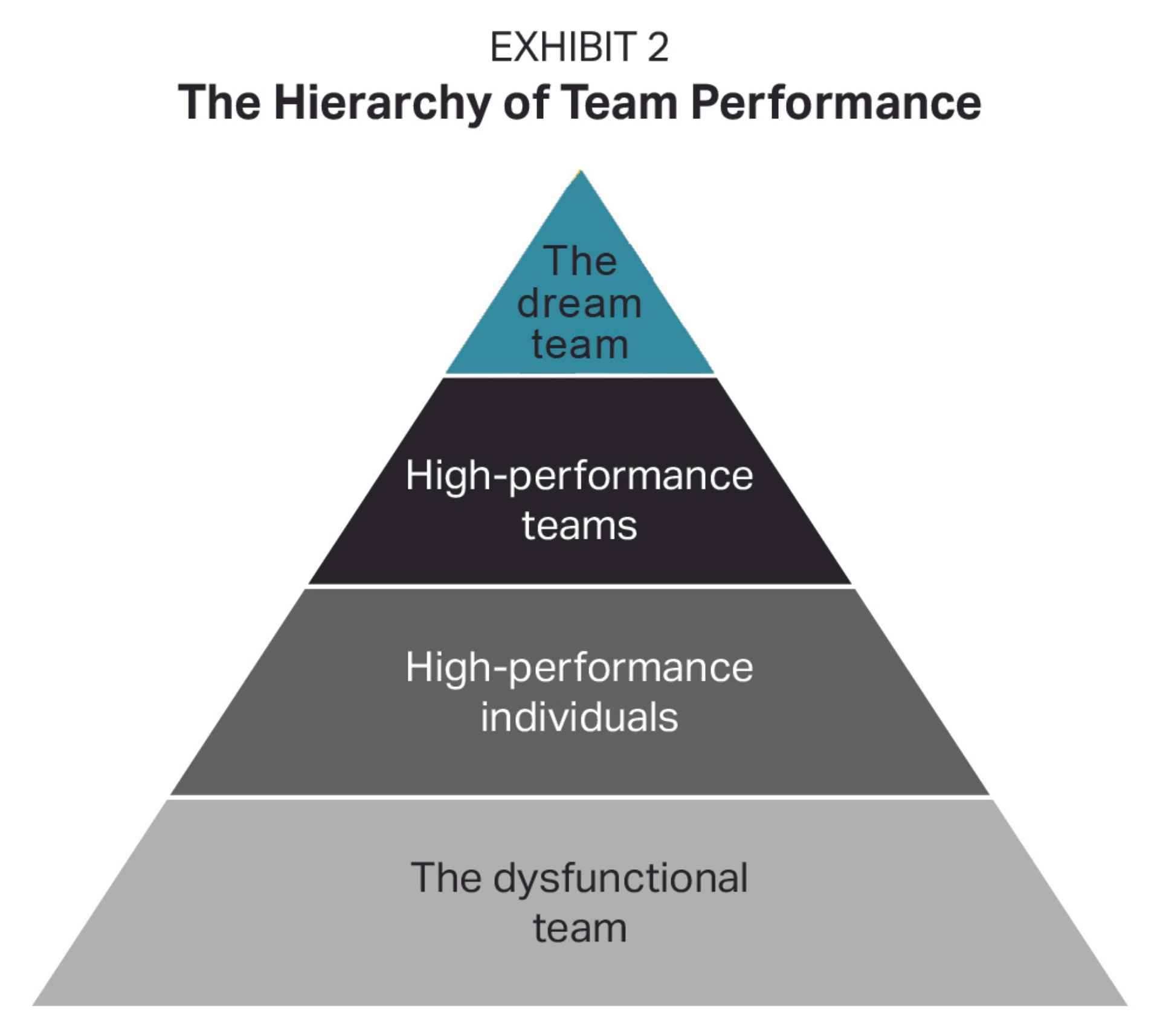Key Takeaways
- Teams can range from dysfunctional to fully aligned dream teams.
- The best teams have members who continually co-elevate each other to new heights.
- Dream teams are intentionally designed to help everyone involved achieve their goals.

In our experience, one fact that highly successful people recognize better than their less-successful peers is that nothing great is ever accomplished alone.
That’s the case whether it’s an entrepreneur running a company, a C-level executive managing a division, an ambitious employee who is part of a team, or a member of an organization or group that is pursuing big goals.
Ultimately, it takes an outstanding and unified collection of people to achieve significant success—both for the group or organization as a whole and for the individuals involved in the effort.
Think about your own goals. You may want to build a hugely successful business or take exceptional care of your clients or others. Regardless, you probably want to build a high quality of life for yourself and your loved ones. Well, aligning yourself with the right people and then working together to co-elevate each other is the surest path we know of to get there. Indeed, it’s what we see highly successful people do every day.
With that in mind, consider some lessons that you can take from these people when building a team and working with others on a team to make greatness a reality.
The hierarchy of teams
The first thing to recognize is that you need a team to accomplish your key goals. That’s true even if you’re a sole proprietor “one-person shop” or you’re going after an objective that is extremely personal to you. To make great strides and achieve breakthroughs, you need to enlist others to get you there. Your team can be extremely formal and structured, or it can be loose and a bit nebulous—but either way, you’ll need “your people.”
The challenge, as you’re probably aware from past experience, is both finding those people and pulling together in the right direction. There’s a big-picture way that teams tend to operate and evolve—a hierarchy of team performance (see Exhibit 2). Understanding the hierarchy can enable you to see at a glance where your team is at the moment and your potential for moving significantly upward so everyone can work together optimally (or as close to optimally as you can get!).

As you can see, the hierarchy is split into four distinct levels:
Level 1: The dysfunctional team
At the bottom is something that nearly everyone has experienced at some point: the dysfunctional team. The members of a dysfunctional team often have the skills needed to do their jobs and may be quite willing to work hard.
However, they lack clarity about their roles, their mission and the way forward to a higher level. As a result, chaos can regularly occur. With no clear path, there can even be an atmosphere of uncertainty, fear and even dread. This creates a ceiling—a real barrier to escaping the dysfunction.
Unfortunately, we see too many people leading and/or being part of dysfunctional teams. This is not because they are not motivated to build great teams. In the case of many entrepreneurs, for example, it happens because business owners become “accidental CEOs”—they start out with the focused goal of creating a great product or providing a superior service, but they end up spending the bulk of their time managing people.
Level 2: High-performance individuals
The second level of the team hierarchy is high-performance individuals. This type of team is created when more and more talented people get added to the mix—a junior salesperson with excellent client service skills or an experienced operations professional, and so on. These additions help move the team away from dysfunction. However, what ends up happening is that these high-performance individuals merely coexist with each other. Yes, the daily chaos is gone. Clients are being served well, and the practice is running more smoothly. But the group at this stage isn’t really a unified and aligned team. There’s little intention to work together to take the operation or the effort to the next level.
Level 3: High-performance teams
That next level is high-performance teams. At this level, there are multiple team members working collaboratively to achieve common goals. At this stage, a team usually experiences some great success, and it feels good and rewarding. This is an enviable position for any team and its members. The challenge, however, is that even high-performance teams can hit a ceiling of “good enough.” Good enough is a trap that can eventually lead to stagnation and even a falling-off in results and outcomes. When that happens, high-performance teams can quickly backslide and return to individuals working in their respective silos—or even to chaos.
Level 4: The dream team
The top of the hierarchy is considered a dream team—one that works together at a level of genuine co-elevation. That’s what happens when team members are all actively helping one another become their best possible selves while helping the business (or organization or group) achieve its most important goals. Everyone is focused on elevating fellow team members and the outcomes. This is why team building at the highest level is not simply about team leaders or bosses—it’s also about everyone involved, because everyone is supporting each other in meaningful ways.
Action steps to enhance a team
The obvious question: What can be done to move a team up the hierarchy to perform at a higher level—and ideally, to reach the pinnacle, the dream team? People who are highly successful at building, enhancing and managing teams—including both team leaders and “rank and file” members—tend to take several key action steps that prove to be effective more often than not.
Step 1: Make everyone a winner.
Members of dream teams understand that their own individual success is intertwined with the success of every other member of the team. Thus, they seek to co-elevate—to lift higher not just themselves but also every teammate. In doing so, dream teams can achieve truly exceptional results that would not otherwise be possible.
Step 2: Build a team of advocates.
Unfortunately, many teams disappoint the people they aim to serve. Others simply deliver the minimum and think that’s enough. Some teams go so far as to delight their clients, adding a bit of value above what is expected. But dream teams know that this is not enough. They know they need to defend their clients—to be true advocates for their clients. Advocacy is what a dream team’s value promise should be all about.
Step 3: Maximize your competence.
Every ambitious person is motivated to learn and increase their competence in crucial skills that help both themselves and their teammates become winners. In dream teams, team members are systematically developed through actions like mentoring, coaching and managing performance. This development comes from the top down and is part of each team member’s internal motivation to be excellent.
Step 4: Have the right people on the bus.
Dream teams are made up of volunteers. That doesn’t necessarily mean they give their time freely—it means they are aligned with the goals and have the passion and skills to reach them. Volunteers believe in the cause, think about how they can help others move forward with new ideas and generally have a positive attitude. However, they also believe that should the environment change unfavorably, they have the capacity to modify the environment or aspects of their own approach.
Step 5: Create your foundation.
Dream teams are clear on their shared values—what the team is trying to create and achieve. Once that clarity of purpose is in place, it’s time to define the strategy and build the foundation that will support the vision. Finally, with those aspects up and running smoothly, teams can recruit talent that is in sync with their vision, strategy, structure and systems.
Step 6: Show up, commit and contribute.
Every member of a team wants to be recognized not just for their contributions to the group/ organization but also for their significance as a person and an individual. Dream teams know how to do this and, as a result, get even stronger commitment and performance from everyone involved.
Step 7: Create quiet confidence.
A dream team can confidently convey their deep knowledge on issues that are crucial to
their goals. This confidence stems from developing their expertise over time—from direct experience and from research where applicable. Armed with facts, insights and proven success from the past, teams don’t have to shout to get noticed—rather, they convey quiet confidence that helps them get taken seriously.
Step 8: Stay on track.
Dream teams don’t automatically remain dream teams—and they recognize that fact. They employ systems and processes, such as goal-oriented benchmarking, that can help ensure they remain on track.
Step 9: Communicate for maximum impact.
A team cannot operate at maximum capacity and achieve ideal outcomes unless there is transparency and a free flow of information among all the people involved. For dream teams to reach their highest potential, they need to amplify the influence of each team member. Members of dream teams work to continually enhance their ability to communicate honestly, accurately and openly with each other and ensure there are no hidden agendas.
Conclusion
If you lead a team of people, you can potentially move your team up the hierarchy all the way to dream team status by taking these steps. If you are a member of a team, you can elevate yourself and your role—and elevate the people around you—by taking these steps. Ultimately, the team these steps help build will be a tightly knit, aligned band of people committed to success as well as to becoming the very best version of themselves.

0 Comments